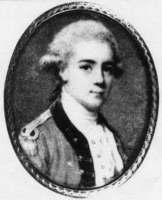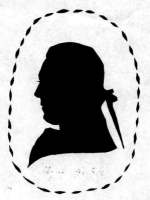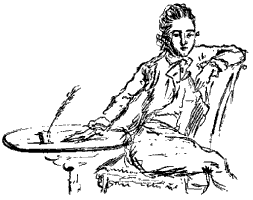


| [ Previous ] [ Next ] |

|
 [more information] |
Attractive; talented as a painter, musician, poet and actor; so charismatic and charming that even his enemies wept as they executed him, John André was one of the most fascinating personalities of the American Revolution. Born May 2, 1750 in London to a French mother and a Swiss merchant father, he was educated on the Continent, where he became fluent in three languages in addition to English.1
After his father's death he dutifully settled down to work at the family business, but longed for the glamour and adventure of a soldier's life. A short time later he fell in love with a young woman named Honora Sneyd, and when she rejected his marriage proposal in 1771, André used his broken heart as an excuse to join the army.
He arrived in America in 1774 and was stationed in Canada when the rebellion broke out. Ending up a prisoner of war after the surrender of St. Johns in late 1775, he spent a miserable year as a PoW in Pennsylvania before finally being exchanged. Upon his return to New York, he presented a set of detailed maps which he'd constructed from memory to Sir William Howe, who made him a captain and recommended him to General Charles Grey as an aide. André remained at Grey's side through the battles of Brandywine, Paoli, Germantown, Monmouth, as well as numerous smaller skirmishes. While he is more often remembered for his artistic accomplishments, André was also an excellent strategist. He was heavily involved in the planning of Paoli and other skirmishes.
 [more information] |
During the winter of 1777-78, while he was stationed with Howe's army in Philadelphia, André came into real prominence -- not for his military accomplishments but for his part in the bright social life of the occupation. He helped to organize a theater group, staged and acted in several plays as well as painting the backdrops. He wrote poetry and songs. He courted the Loyalist belles of the city, including Peggy Shippen and Peggy Chew. The social season (and the occupation) ended with the Mischianza, an enormously elaborate farewell party for Sir William Howe, of which André was the designer and director.2
While in Philadelphia, he became close friends with Banastre Tarleton. They were both part of the "court" of high-spirited, well-educated young officers who flocked around Sir William Howe, and they shared an interest in the theater. Tarleton was a member of André's acting troupe, and also served as one of the "Knights of the Burning Mountain" in the jousting pageant that formed part of the Mischianza.
In November 1778, André was promoted to major and joined Sir Henry Clinton's staff as an aide. Clinton was widely known for his inability to get along with his aides for any length of time, and a series of withdrawals (voluntarily or otherwise) by his staff to other postings soon saw André slipping into the recently vacated post of deputy adjutant general. Unlike his predecessors, he mastered the art of remaining friends with his prickly and insecure boss. In fact, he soon earned so much of Clinton's confidence that he was given another, unpublicized role: that of Chief of Intelligence for the British Army.
A few months after the British left Philadelphia, André's former amour, Peggy Shippen, married a rebel general by the name of Benedict Arnold. By May 1779, Arnold was negotiating secretly with André for the surrender of the fort at West Point. There has been much speculation on what role André's connection to Peggy played in the situation, but all that is known for certain is that she and André did correspond.
Negotiations with Arnold bogged down, and André was drawn away by the planned invasion of the Carolinas. He accompanied the fleet to Savannah, and during the siege of Charleston is reputed to have crossed the lines on spy missions into the beleaguered city by passing himself off as a Virginian.
After Charleston surrendered, André preceded Clinton back to New York. He and Banastre Tarleton kept up their friendship through private correspondence, and whenever Tarleton wanted something he couldn't get from Cornwallis, he was not above going over the boss's head and requesting that André use his influence over Clinton to achieve it.
 [more information] |
Once he was back in New York, André reopened negotiations with Arnold, though they continued to drag on until September 1780. By then, arrangements seemed to be close to finalized, so when Arnold demanded a personal meeting, André agreed.
The decision proved fatal. Caught out of uniform behind rebel lines after his meeting with Arnold, André was arrested for spying. Arnold heard of his arrest in time to escape, but John André wasn't so lucky. He was held prisoner for several days, during which time he made friends with his captors including the Marquis de Lafayette and Alexander Hamilton. Washington and Clinton negotiated to have him exchanged, but Washington's price for André was the return of Benedict Arnold. Clinton was forced to refuse. Washington, in return, refused to grant André an honorable soldier's death by firing squad. He was hanged on October 2, 1780, in Tappan, New York.
It is interesting that one of Ban Tarleton's closest friends in America suffers from the exact opposite problem with his historical press. Whereas Ban is almost universally vilified, John André is nearly always whitewashed into a winsome, romantic and tragic figure. He was all of that, true, but he was many other things besides -- a soldier more than capable of professional ruthlessness, a clever and manipulative spymaster, a powerful behind-the-scenes force within the British army. His influence over Sir Henry Clinton was complex and the extent of it remains the subject of considerable controversy.
Honora Sneyd, the young woman who rejected André's youthful courtship, was the foster sister (and possibly lesbian partner) of poet Anna Seward. Seward remained friends with André through the remainder of his life and eulogized his death in a poem called Monody, published in 1781. The dedication to Sir Henry Clinton begins: "Sir: With the Zeal of a religious Enthusiast to his Murdered Saint, the Author of his mournful Eulogium consecrates it to the Memory of Major André, who fell a Martyr in the Cause of his King and Country, with the firm Intrepidity of a Roman, and the Amiable Resignation of a Christian Hero."
Yes, well... Did I mention that Anna was inclined towards somewhat overwrought flights of poetic fancy?3
She held George Washington in considerable contempt for his decision to hang André rather than granting his plea to face a firing squad, and expressed her anger in Monody:
"Oh Washington! I thought thee great and good,
Nor knew thy Nero thirst for guiltless blood:
Severe to use the pow'r that fortune gave,
Thou cool determined murderer of the grave.
Remorseless Washington! the day shall come
Of Deep Repentance for this barb'rous doom!
When injured André's memory shall inspire
A kindling army with resistless fire;
Each Falchion sharpen that the Britons wield,
And lead their fiercest Lion to the field!
Then, when each hope of thine shall set in night,
When dubious dread, and unavailing flight
Impel your host, thy guilt upbraided soul
Shall wish untouch'd the sacred life you stole!
And when thy heart, appalled and vanquished pride,
Shall vainly ask the mercy you denied,
With horror shalt thou meet the fate thou gave,
Nor pity gild the darkness of thy grave."
[ Full Text ]

|
In The Beloved Spy, Harry Stanton Tillotson mentions an interesting follow-up to this literary attack, documenting it to a letter Seward wrote to her friend Dr. Simmons of Manchester in 1802. In this letter, Seward claims that Washington read the poem after the end of the war, and the censure prompted him to send an "aide-de-camp" to her with documentation on the incident. The aide-de-camp explained the reasoning behind his decision to her satisfaction. (A few years of cooling-down time presumably helped, too.) She adds, "General Washington did me the honour to charge his aide-de-camp to assure me, that no circumstance of his life had given him so much pain as the necessary sacrifice of André's life."
André lay buried by the Hudson River until 1821, when his remains were disinterred and shipped home to England. He was reinterred in Westminster Abbey, London, his presence marked by a monument on the periphery of Poet's Corner. (The latter honor was driven more by politics than the immortality of John's poetry.)
Elsewhere on the site I review the wide range of media interpretations of Banastre Tarleton, but André holds the prize for weirdest fictional appearance, having guest starred in an episode of Irwin Allen's 1960s sci-fi cheez-fest, Voyage to the Bottom of the Sea. In the show's final episode, "No Way Back," the submarine Seaview travels back in time to the American Revolution and plays accidental and unwilling host to André and Benedict Arnold. Short of ending up aboard the starship Enterprise, I don't see how Ban Tarleton will ever beat that one.
In the 1950s, an American film called The Scarlet Coat told a surprisingly sympathetic recounting of the André/Arnold story. While centered around two fictional characters and modified for drama, it provides an unusual amount of accurate historical detail, including direct quotations from various of the persons involved.
And, of course, the recent TV movie, Benedict Arnold; A Question of Honor supposedly featured André, though the less said about that thoroughly wooden portrayal, the better. (Not the best part of the film, shall we say. The same actor was excellent in Aristocrats, so his failure here likely had much to do with the script and direction.)
John André appears in numerous novels, usually being granted far more sympathetic portrayals than Ban Tarleton. He is featured in Enough Good Men, Hugh Wynne, Free Quaker, The Painted Minx, The Exquisite Siren, A Patriot's Heart, and Proceed, Sergeant Lamb which appear on the book reviews page.
Other novels featuring André appearances include,
His story has been adapted for the stage a number of times. As early as the 1790s, William Dunlap penned "André; a Tragedy in Five Acts" (reprinted: New York: Burt Franklin Research and Source Works Series, 1970), and in the 19th century playwright Clyde Fitch produced "Major André" (in Plays, Boston: Little, Brown and Company, 1915). In between came at least half a dozen other plays according to the introduction in the Dunlap edition above. That introduction also claims that Dunlap's is the best of the lot, which is pretty scary given that it features truly awful blank verse, not to mention an unexpected visit to André in captivity by Honora Sneyd.
Numerous books have been written on John André, particularly in relation to his negotiations with Benedict Arnold.
Reputedly, John kept a private journal, in which he doodled sketches, maps and poems, which was "acquired" by one of his captors after his death, and hasn't been seen since. In his professional capacity as General Grey's aide-de-camp, he also kept a regimental journal, one volume of which was found among the Grey family papers around the beginning of the 20th century. It was subsequently published as Major André's Journal; Operations of the British Army under Lieutenant Generals Sir William Howe and Sir Henry Clinton June 1777 to November 1778 (North Stratford, New Hampshire: Ayer Company Publishers, Inc., 2000, a reprint of the 1930 edition ). It contains tons of minutiae, but is entirely dry and businesslike.
| [ Index ] | [ Previous ] [ Next ] |
1 May 2 is a new-style date. The date of John's birth has been the subject of some disagreement. It is often given as May 2, 1751 (in fact, his monument in Westminster Abbey uses that date, listing him as twenty-nine at the time of his death rather than thirty). In recent years, the 1750 date has gained general acceptance, and there is an IGI record with the proper parental names for it. [ back ]
2 In his study of theater during the Revolution, Jared Brown casts doubts on some of the traditionally accepted information relating to André's participation. Much of it comes from eyewitnesses who wrote down their recollections years later, after his capture and execution had romanticized his life. See Jared Brown, The Theatre in America during the Revolution (New York: Cambridge University Press, 1995). His participation as a scene painter and an occasional actor seems certain, as well as his extensive involvement with the orchestration of the Mischianza. [ back ]
3 In The Life and Career of Major André (Boston: Ticknor and Fields, 1861), Winthrop Sargent offers this amusing evaluation of Anna: "She was besides of an enthusiastic, not to say romantic disposition, and not a little addicted to the perpetration of a sort of poetry, 'most of which,' says her friend and biographer, Sir Walter Scott, 'is absolutely execrable.'" (p11) [ back ]
| Return to the Main Page | Last updated by the Webmaster on October 12, 2005 |